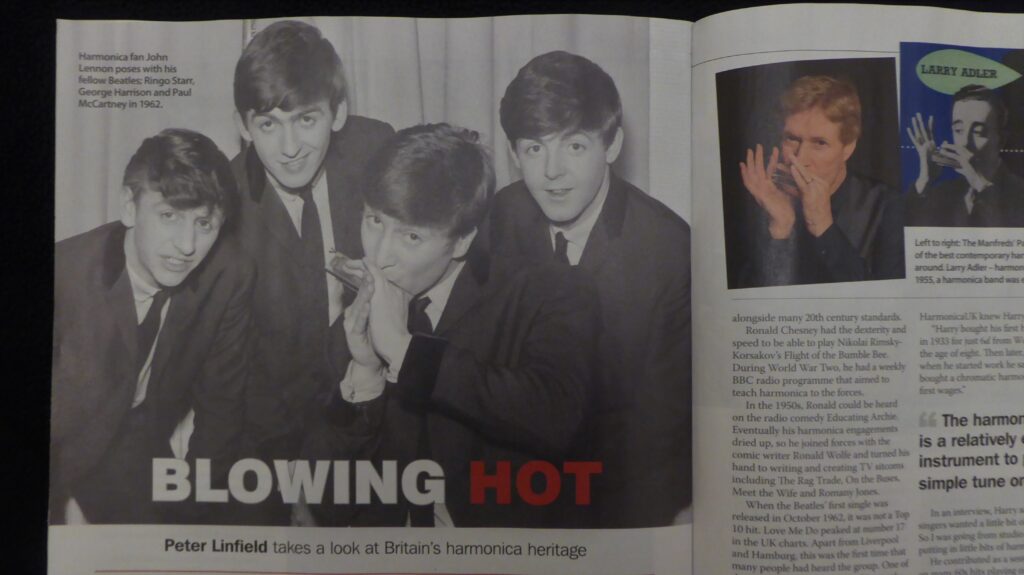Eighteen months ago I bought my first harmonica. This month I published a magazine article on this amazing little instrument.
This is my seventh article published by Best of British Magazine. Four have been on Dad’s Army actors, one on Parkgate and another on Hawarden’s, Gladstone Library.

For hygiene reasons you can’t try out a harmonica in a shop so I bought my first one online from Eagle Music, a family run business based in Huddersfield, which has a good reputation.
The harmonica is a unique instrument in so many ways. It’s a wind instrument. You can play single notes as well as chords and, on the diatonic version, you can also bend notes. To my knowledge this is the only wind instrument that you can do this with.
A ten hole diatonic harmonica is four inches long, extremely light and easy to carry on your person.
Back in the 1960’s the sound of the harmonica gave many hit records a distinctive introduction. Think of Harry Pitch’s intro to Frank Ifield’s hits, John Lennon’s contribution to some early Beatles songs and even Judd Lander’s opening rifts to some of Culture Club’s hits of the1980’s.
Those hits are instantly recognisable by their harmonica introductions. I have always appreciated the musicians who don’t take the limelight yet their contributions often make a good piece of music into a memorable one.
What is my fascination with the harmonica?
There are two images in my subconscious memory that concern harmonica players. I have seen neither of these and yet they represent pictures that always seem to have been somewhere in the recesses in the back of my mind.
One image is that of a soldier during World War One. The sound of his Harmonica drifts along the trenches and over no man’s land. It is near Christmas and he is playing Silent Night.
The other image is of a street busker on a cold winter’s night, the fog is down and he stands under a lamppost wearing a cap and a long winter coat. The street is busy with Christmas shoppers. He’s probably playing Ewan McColl’s, Dirty Old Town or perhaps the tune to the 1960’s BBC TV programme Dixon of Dock Green. He wears fingerless mitts and when he pauses for breath it condenses into clouds of mist. It is freezing and I am cold. I pay little attention to him and hurry on home.
Back in time, on the 9th December 1975, my friend John Griffiths and I saw Paul Simon at the Birmingham Hippodrome Theatre. It was the Still Crazy After all these Years tour. Paul always used phenomenal musicians on both his albums and on tour. During this concert, one guy seemed older than the others, he played some bluesy pieces on the guitar. At some point Paul played one of his most exquisitely beautiful songs, I do it for Your Love, and the old guy puts down his guitar and produces a chromatic harmonica… and he weaves his magic in and out of the melody. His simple contribution made a good song great. I was 19 years old and the old guy would have been 53 at that time. It was Toots Thielemans.
Back then, I had no real idea who Toots Thielemans was and it was only after many years that I began to appreciate his work. If you have heard the theme music to Midnight Cowboy or Sesame Street, then you have heard Toots. In truth Toot’s playing was so much more than that of a good session musician; he was a star in his own firmament. Sadly, Toots passed away in 2016 but his legacy is that of one of the great harmonica players of all time. Today we have to look to Hermine Deurloo and William Galison to find comparable musicians. Both have played Toot’s, Bluesette and can be found on the YouTube archives.
In Brussels, a metro station is currently being constructed. Due for completion in 2025, it will be named after Toots Thielemans.
Amongst my current favourite diatonic harmonica players and worth checking out on YouTube are Indiara Sfair and Leandro Lopes who both occasionally team up with the Brazilian Blues Band, Milk’n Blues.
I have been watching, Indiara Sfair’s tune Improvisation in Cm for some time now on YouTube and find it difficult to believe what this musician is capable of. She has taken the Diatonic Harmonica to an unbelievable new level.
Sadly, my own playing is comparable to that of a ten year old learning to play a school recorder, but what the hell, for the first time since I was 11, and the afore-mentioned recorder, I’m playing a musical instrument.
My article on Britain’s harmonica heritage has been called Blowing Hot and it appears in the December Issue of Best of British Magazine.


